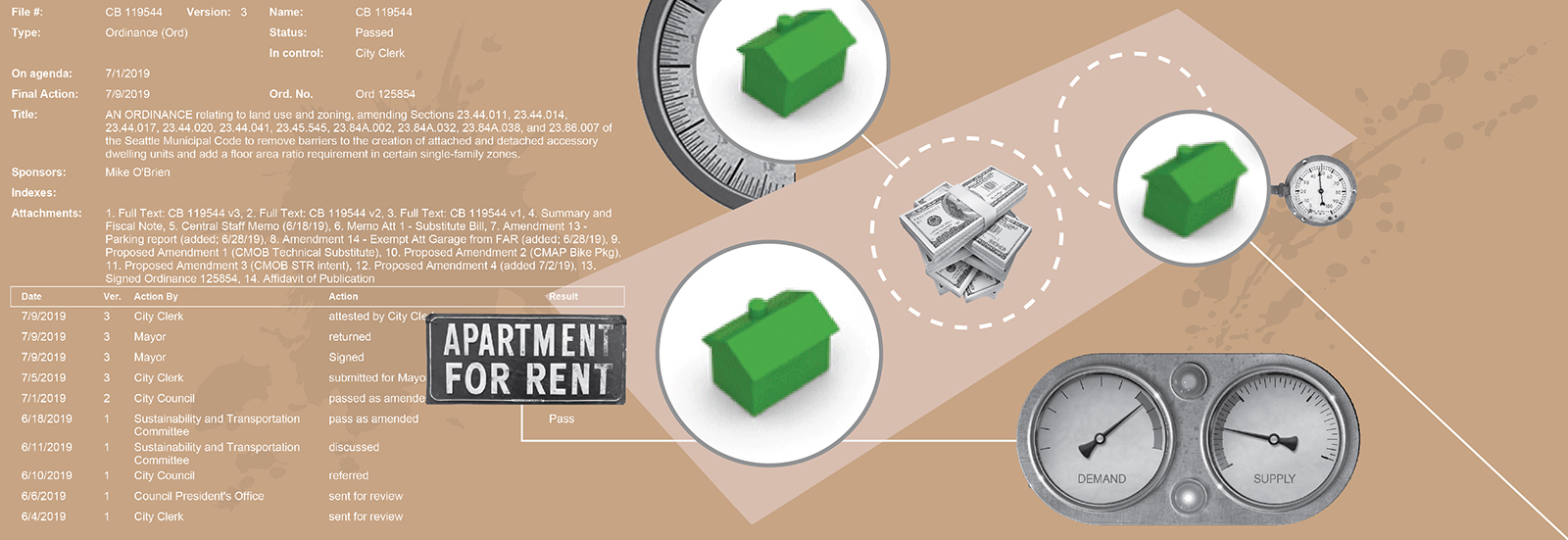In August 2019 the Seattle City Council approved game-changing legislation for Seattle’s zoning code. Historically, single-family (SF) lots in Seattle could either include an accessory dwelling unit (an ADU, aka a mother-in-law apartment), or a detached accessory dwelling unit (a DADU, aka a backyard cottage). The new legislation changed all of this by allowing an ADU and a DADU on any single-family lot in Seattle. The new legislation also eliminated restrictive codes, such as parking requirements, and increased the allowable area of ADUs and DADUs. Whether Seattleites know it or not, the nature of homeownership changed significantly with this legislation—not just for homeowners, whose properties’ potential and value took an enormous leap, but also for future homeowners who now have financial leverage, and renters who now have more options.
Owners of SF lots in Seattle should follow the lead of the new legislation: rather than assuming the outdated notion that the single-family house is their only choice, they should consider the possibilities from the perspective of a developer and landlord of a triplex. The potential is far-reaching.
For property owners who feel as though they’re getting priced out of Seattle, creating two rental units on their land can take a substantial dent out of their mortgage. Busy families can add housing for grandparents, bringing the family closer together and providing built-in childcare; those looking to downsize can develop a new flat for themselves while renting out their primary residence; and elders can create independent retirement housing on their own lots.
Seattleites who don’t currently own property but aspire to, may feel that homeownership is beyond their reach due to the disproportionate relationship between the cost of real estate and average incomes. The recent legislation changes this, as a home mortgage may now be offset by the revenue from one or two rental units. Of course there will be challenges; creating new structures comes with a price tag, and some banks don’t take rental income into consideration when evaluating a buyer’s fiscal fitness.
This is also a great advancement from an urban planning perspective. This pro-density legislation promotes greater proximity to the workplace and less reliance on the automobile. The diversity of housing offered by the zoning code change supports affordability and equity—not just for the homeowners, but also for renters who will have more choices within the city. And it helps to create important layers of housing types, varied aesthetics, and a diverse demographic. It’s what vibrant cities are made of.
For skeptics who dismiss all of this as idealistic or hypothetical, examples proving otherwise abound. BUILD’s own portfolio of Case Study Houses offers three different solutions to the evolving density in Seattle.
Case Study House 2014
The lower level of this residence in Seattle’s Ravenna neighborhood was prepped with the proper utilities, circulation, and security for a prospective accessory dwelling unit. This preparation (which is relatively inexpensive within the construction of a new home) allows for a future straight-forward build-out of a mother-in-law or rental space.
Case Study House 2016
Building on CSH 2014, the first level of this three-level residence in Seattle’s Green Lake neighborhood includes a completely independent apartment unit, which is currently inhabited by a grandmother who’s thrilled to be close to her children and grandchildren. Three generations of a family living under one roof is a traditional building block of an established city.
Case Study House 2017
Building from experience and taking it one step further, this Ballard residence includes a detached accessory dwelling unit in its backyard. Designed above the garage of the primary residence, the DADU is completely autonomous and can be entered from the alley. It’s a pleasant 1,000-square foot apartment unit with a fantastic view, and in a great neighborhood.
The new legislation creates more possibilities still, and BUILD is ready to design, permit and build the next layer of opportunity, diversity, and equity in our growing city.
Cheers from team BUILD









